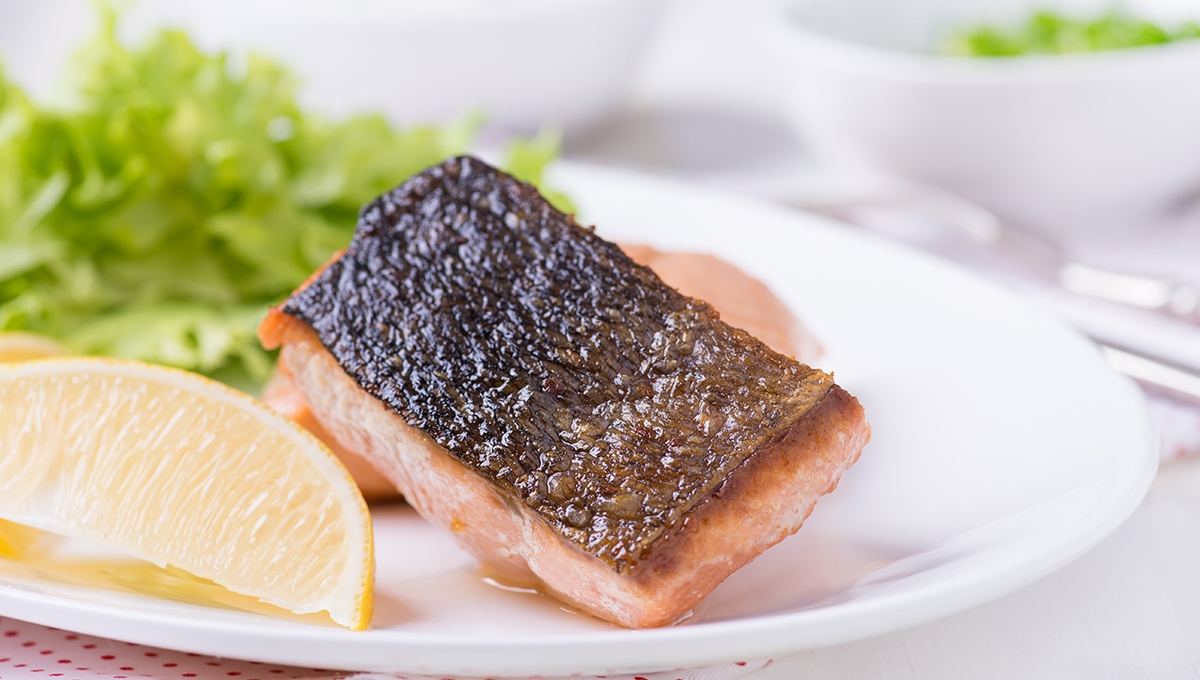Explore web search results related to this domain and discover relevant information.
Fish skin really is the best part of the fish, yet, sadly, it's often discarded. Here's how to make irresistible crispy fish skin every time.
Do you always take the skin off your fish fillets before you cook? You're not alone. Many people assume fish skin always has an off-putting texture or is even not consumable. But cooking a fillet, especially from a fish such as wild salmon or whitefish, is actually easier with the skin on.You'll find crispy fish skin tastes much like whatever fish you're dining on, whether wild salmon, Alaskan cod, Chilean sea bass or something else, albeit with a rather more substantial, and we would say equally delightful, texture.The key to tasty skin-on fish is to thoroughly dry the fillets before cooking. Drying it can be as simple as leaving the fillet on a plate skin-side up and uncovered in the fridge for an hour before cooking. You can also pat it dry with paper towels or a clean, cotton kitchen towel.It's likely your bad memories of fish skin are due to chefs (or home cooks) who started with wet fish. Extra moisture steams the skin, leaving it soggy and unappetizing. Soggy skin is also more likely to stick to your pan and become harder to take off while you're eating, and subsequently cleaning.


Kerecis, the company pioneering the use of sustainably sourced fish skin in cellular therapy and tissue regeneration, will present its clinically proven fish-skin graft technology at the Symposium on Advanced Wound Care (SAWC Fall) 2025, taking place September 3 - 6 at Caesars Forum in Las Vegas.
Visitors will also experience Kerecis’ new volcano-themed booth design, symbolizing the transformative power of Icelandic nature and the regenerative potential of lava, an inspiration that parallels the healing properties of Kerecis’ intact fish-skin technology.At a symposium entitled “Current of Care: Navigating Patient Access and Documentation Demands for Success with Fish Skin” on September 4, Dr. John Lantis, Chairman of the Kerecis Scientific Advisory Board, will moderate a discussion with Kathleen Schaum, MS, and Mark Suski, MD.On September 5th from 4:00 to 6:00 PM, Kerecis will host its premier educational event “Taste of Iceland”, a gathering that blends cultural discovery with clinical learning. Dr. John Lantis will review findings from the largest randomized controlled trial of a skin substitute for diabetic foot ulcers with exposed bone or tendon, as well as highlight current research initiatives involving intact fish-skin grafts.Randy Semma, DPM, Split Thickness Skin Grafts with Transmetatarsal Amputation · Gregory Sheremeta, DPM, Advanced limb salvage techniques in an acute diabetic necrotizing soft tissue infection with exposed calcaneus. Utilizing an Icelandic fish skin substitute and adjunctive NPWT with static external circular offloading.

Salt-baking a fish can be a great way to present a delicious meal to your dinner guests, but there's one part of the dish you should avoid: the skin.
Many different meats can be salt-baked, but the method is commonly used on whole fish, as it simplifies the process and looks visually impressive when an entire seasoned fish is placed on the dinner table. However, there is one part of a salt-baked fish that is nearly inedible: the skin.While most fish skins are completely safe and nutritious to eat — with some exceptions, such as the skin on skate fish and other popular deep-sea fish — all of that value is undermined by the sheer excessive saltiness of salt-baked fish skin. The taste will be replaced with that of a mouthful of ocean water, and the nutritional value is null and void thanks to the excessive amount of salt, which is bad for your heart.Therefore, be sure to remove the skin before eating. ... Cooking a salt-baked fish is no herculean task. In reality, it's quite simple.After the fish cooks to the proper internal temperature and you remove it from the oven, you'll need to both crack the salt crust and then remove the skin to ensure you're left with only perfectly seasoned meat. If you're serving the dish at a gathering, this step is often done at the table, as revealing the fish can be a fun bonding experience that gets everyone excited for the meal.

The use of fish skin grafts as xenografts is a promising alternative for wound healing. Several studies have shown fish skin grafts to be a safer and more effective option compared to other alternatives, due to the large amount of fatty acids, including omega-3, which have been proven to promote ...
The use of fish skin grafts as xenografts is a promising alternative for wound healing. Several studies have shown fish skin grafts to be a safer and more effective option compared to other alternatives, due to the large amount of fatty acids, including omega-3, which have been proven to promote wound healing.Several studies have shown fish skin grafts to be a safer and more effective option compared to other alternatives, due to the large amount of fatty acids, including omega-3, which have been proven to promote wound healing. The purpose of this study was to evaluate the efficacy of fish skin grafts as wound dressing.A literature search up to March 2024 was conducted using the electronic databases of PubMed, Cochrane, and ScienceDirect. A total of 158 patients from six studies were included in this systematic review. All studies showed early wound healing using fish skin grafts; one study showed that wound healing was halved compared to paraffin gauze.Complete wound healing using fish skin grafts was noted as early as 30 days. Out of 114 patients treated with fish skin grafts, 1 patient showed signs of infection, and no patients showed allergic reactions. One study also found that fish skin grafts provide satisfactory wound scar quality.
But when my husband saw me attempting it (swearing under my breath) with a walleye fillet yesterday he coached me with the skill he learned from fishing with his Dad. For me, the key points I’d gotten wrong from just reading about it - Put the fish SKIN SIDE DOWN on a FLAT ...
This post is for anyone else who is as intimidated by trying to prepare raw fish (before cooking it) as I was. I don’t fish and never learned the technique for removing the skin from the flesh of a raw purchased fillet. But when my husband saw me attempting it (swearing under my breath) with a walleye fillet yesterday he coached me with the skill he learned from fishing with his Dad.This post is for anyone else who is as intimidated by trying to prepare raw fish (before cooking it) as I was. I don’t fish and never learned the technique for removing the skin from the flesh of a raw purchased fillet…


Cooking fish in stainless steel doesn't have to end in disaster. Here's how to get restaurant-worthy crisp, golden skin that releases from the pan every time, according to a chef.
For fish with crisp, golden skin that won't stick to the bottom of the pan, dry the skin thoroughly, add enough oil to coat the skillet, heat until you see the faintest smoke, and cook mostly skin-side down without moving it before flipping.Few sounds in the kitchen are as thrilling to me as the first sizzle of fish skin hitting a hot pan. The crackle of fat and the faint whiff of the sea turning savory are a promise that you're just minutes away from a piece of fish crowned with a golden, shattering crust.Done right, crisp skin is a work of art: glassy and wafer-thin, giving way to tender, succulent flesh beneath. And yet, many cooks encounter the darker side of this story when using a stainless steel skillet to sear fish. You go to flip your fillet, your spatula poised with care, only to find the skin fused to the pan, refusing to let go.You tug once, then again, until it finally releases—leaving behind a sad patchwork of skin where there should have been a crisp, golden sheet. The moment that was supposed to be triumphant turns into one of quiet defeat, the kind that has you swearing you'll never cook fish in stainless steel again.

Acellular fish skin grafts (FSGs), created from the minimally processed skin of the Atlantic cod, are a type of xenograft, a biologic scaffold that can aid in wound healing. These FSGs may be a novel
When served a fish entrée with the skin still on it, should you eat the skin? —Suzi M., St. Louis
The skin was left on for stability and ease of handling, though not necessarily for consumption. Subscribe to the St. Louis Dining In and Dining Out newsletters to stay up-to-date on the local restaurant and culinary scene. We will never send spam or annoying emails. Unsubscribe anytime. This site is protected by reCAPTCHA and the Google Privacy Policy and Terms of Service apply. In the past 15 years or so, as chefs realized the importance of fish skin as a food source, they treated it with as much reverence as the flesh.It’s now commonplace for chefs to season and then sear the skin until crispy, then serve the fish portion skin side up. These days, a good rule of thumb is that if your snapper, bass, trout, or salmon is plated that way, the flavorful skin is intended to be eaten.Today, some avant garde menus include baked or crispy fried salmon skin as a standalone or use it in handrolls (as served at Nick Bognar’s indo, aming other places). · That said, certain fish skins just don’t taste all that great (just like certain cheese rinds).Fish skin is a good thing, most of the time.


The Skin Fish is an uncommon enemy found in the Volcanic Depths. The Skin Fish is a large creature with a rough exoskeleton-like structure that grants it a distinctively skeletal appearance. It is unknown if its name is an ironic way to refer to its seemingly skin-less appearance, or if its ...
The Skin Fish is an uncommon enemy found in the Volcanic Depths. The Skin Fish is a large creature with a rough exoskeleton-like structure that grants it a distinctively skeletal appearance. It is unknown if its name is an ironic way to refer to its seemingly skin-less appearance, or if its carapace-like formation was once the fish's skin, becoming what it is now as an adaptation to the environment the creature dwells in.Unlike most other fleeing critters, the Skin Fish seems to mostly ignore the Submarine, and will often continue swimming around randomly once it detects the vessel, frequently getting in between the Turret and any enemies the gunner is attempting to shoot, soaking up bullets and accidentally protecting the other creature.The Skin Fish is not aggressive in any way, and will often be found randomly swimming around the Volcanic Depths.This goes both ways, however, and the Skin Fish will often block the path of other, more dangerous fish and helping the Submarine escape from tough situations.
Crisping fish skin in the pan is one of those techniques that's used all the time in restaurants, but almost never at home. Sure, it takes some finesse, but that's all the more reason to master the process. Here's what you need to know to get perfectly crisp skin every time.
If I had to name three kitchen skills I wish more home cooks endeavored to master, they'd be: learning to work more cleanly, cutting more efficiently (and safely), and knowing how to crisp the skin of a piece of fish. That last one is a lot more specific than the other two, but I rank it just as highly because it's one of those tasks that demonstrates real kitchen finesse.If that sounds daunting to you, you're not alone. Trying to pan-roast a crisp-skinned fish is, based on my incredibly unscientific and anecdotal experience, something that most home cooks don't ever attempt. They should, though, since it's not nearly as difficult as it seems.The key to the whole process is learning to control both heat and moisture. Get those parts down, and you'll be marveling at your crisp-skinned fish in no time, no matter if you're cooking snapper, salmon, or bass.Liquid will collect on the knife's edge as you literally scrape it from the skin; wipe it up with a paper towel every few passes, then go back and scrape some more. I do this over and over until the knife comes up dry with each pass. Just be careful not to press too hard. Fish is delicate, after all, and you don't want to smash it.
:max_bytes(150000):strip_icc()/__opt__aboutcom__coeus__resources__content_migration__serious_eats__seriouseats.com__images__2015__09__20150925-crispy-fish-skin-vicky-wasik-24-1bfcae2c33db4560bbe7e5fd4400cdbc.jpg)

CNN Health is spotlighting Driscoll Children’s Hospital for a remarkable case in which a fish skin graft helped heal a life-threatening wound on a preterm infant. Born at just 23 weeks and weighing only one pound, Eliana faced overwhelming odds— including a severe infection on her neck.
Dimas and Nurse Reyna traveled to the European Wound Management Association Conference in Barcelona, Spain. They presented data from two complex cases that used the fish skin graft: Eliana, and another critically ill preterm infant born who weighed just one pound when the graft was applied.Born at just 23 weeks and weighing only one pound, Eliana faced overwhelming odds— including a severe infection on her neck. When traditional treatments proved too risky, Driscoll Pediatric Plastic Surgeon Dr. Vanessa Dimas and Nurse Practitioner Roxana Reyna turned to an unconventional solution: fish skin grafts.Driscoll Pediatric Plastic Surgeon Dr. Vanessa Dimas and Nurse Practitioner Roxana Reyna assemble the use of the Kerecis fish skin graft.In the News: CNN Highlights Driscoll’s Use of Fish Skin to Heal NICU Baby

The method to clean them before cooking is a little different than other species such as bluegill or trout. I’ll show you two ways to fillet your whiskered catch: by first skinning them (a unique method for catfish) or by using the traditional fillet-and-skin method common to other fish.
Catfish have a more pronounced ribcage than other fish such as bass and bluegill. This is due to their pin bones and rib bones being fused together, making for a wider ribcage. So once your knife is above the ribcage of the catfish, cut along the spine until you feel the ribs with your fillet knife. Follow that contour before pushing the knife through the meat along the line where the catfish was skinned.Do this for both sides, and you will have two boneless and skinless catfish fillets ready for the fryer. · Now, the second method for cleaning catfish is the traditional approach to cleaning fish, and the one I usually use for larger catfish.Now that you have the fillets off the catfish, discard the frame, and wipe off the cutting board. It’s time to skin the fillets. Skinning catfish this way can be a little more difficult with smaller fish; with no scales to back the skin, you can push the knife through the skin more readily.Now, with the skin gone, we are going to fillet the cat like any other fish. I recommend starting near the adipose fin of the catfish, keeping your knife flat to the bones.
Today we're going back to basics and learning how to skin a fish fillet.
You are probably wondering: why on earth should I learn how to skin a fish when I can buy it already skinned from the grocery store? Actually, some fish fillets come with the skin still on. This can be wonderful if you’re pan-frying the fish (without breading) because the skin gets nice and crispy and so delicious.But if you’re planning to bread the fish or bake it, then the skin does not get crisp and is instead soggy and pretty gross. You need to get it off! So if the best-looking fish at the store, or the fillets that are on sale, have the skin on but you weren’t planning to pan-fry, don’t worry.Hold the fish tight with your hand while you gently move your knife through the fish. Sometimes your knife may slip and you miss a part of the skin, that’s okay!Today we’re going back to basics and learning how to skin a fish fillet.

Business Wire’s press release distribution, investor relations services, and public relations solutions amplify your news to reach global audiences.
Fishskyn creates unique, original, and premium quality device skins with easy installation and precise fit. Shop device skins for Apple, Samsung, Google, Microsoft, and more!
What is a Fishskyn · Customize your own MacBook skin $42.00 USD · Statement (MacBook Skin) $31.00 USD · Jet-Black (MacBook Skin) $31.00 USD · Indy (MacBook Skin) $31.00 USD · Obsidian (MacBook Skin) $31.00 USD · Banff (MacBook Skin) $31.00 USD · Yeti (MacBook Skin) $31.00 USD ·


Learn how to remove a fish hook from your skin safely and effectively with our comprehensive guide. Empower yourself for fishing mishaps!
Learn how to remove a fish hook from your skin safely and effectively with our comprehensive guide. Empower yourself for fishing mishaps!-page1Imagine a perfect day out on the water, rod in hand and hope in your heart for a big catch. But suddenly, the thrill of fishing takes a painful turn, and you find yourself in the all-too-common scenario of a fish hook embedded in your skin.If you’ve ever faced this perilous predicament or simply want to be prepared for the unexpected, understanding how to remove a fish hook from your skin safely and effectively is essential knowledge for any outdoor enthusiast or angler.Whether you are an avid fisher or enjoy leisure outings, knowing how to handle such mishaps can determine the difference between a fun day and a trip you would rather forget. This blog post serves to equip you with the knowledge not only to safely remove a fish hook from your skin, but also to take appropriate aftercare steps to prevent complications.
Fish skins might just be the best kept secret in seafood. Find out why you should consider including more fish skin in your diet—whether via skin-on fillets or fish skins perfectly prepared a la carte.
You’ve likely heard that many species of fish are great sources of Omega-3s. The polyunsaturated fat plays a key role in cardiovascular health and cell repair, and has been shown to reduce inflammation. Although most of the omega-3s in fish are found in the fillet, the skin contains a fair amount of the much-desired fatty acid, too.For example, our 4-ounce skinless barramundi contain 650 mg of omega-3s. Our 4-ounce, skin-on barramundi have 1.5 g of omega-3s. That’s almost twice as many omega-3s when you eat the skin! Chefs have long been privy to how delicious fish skins can be, both on a fillet and as a stand-alone ingredient.At Bar Melusine in Seattle, chef Renee Erickson serves fried salmon skins with salmon roe and aioli. At the Four Seasons Hotel Hong Kong, chef Chan Yan-Tak serves lightly battered and fried fish skins with a decadent salted egg yolk sauce.We often get the question, “Are fish skins safe to eat?” The quick answer, yes. However, because the skin of a fish is exposed to its environment and pollution, it’s important to know where your fish is coming from. Stay away from farmed or wild fish from more polluted areas or farms that use chemicals and antibiotics.

Here's a list of fish with skin that goes crispy when pan seared. Not all fish skin will go crispy - some are too thin or the texture too rubbery.
This is a list of fish with skin that will NOT go crispy when pan seared. This can be because the skin isn’t suitable for crisping (eg. too thin or wrong composition), is not a pleasant texture for eating when pan-seared, or it’s simply too difficult to achieve (eg.Everybody loves a juicy piece of fish that comes with a shatteringly crispy skin! But not all fish has skin that will easily go crispy when pan seared.Here’s a list of common fish that WILL get crispy skin – and those that will not!This is a list of fish with skin that will go crispy when cooked on the stove, covering the most common fish in the largest readership countries.


The Fish Skin with Smoked Milkfish (Bangus) in Torch Ginger Vinaigrette was a play on texture with the catfish skin fried to a crisp serving as a bed for the creamy bangus mousse and the spicy ginger.
Small bites: (clockwise from top) Century Egg Kaya Toast with Caviar, Fish Skin with Smoked Milkfish Mousse in Torch Ginger Vinaigrette, Fish Tartlet with Weaver Art Salt, Fried Siopao with Chicken Asado and Fermented Black Garlic Sambal TumisI LOVE food. I’m a person, who, when offered any dishes anytime or anywhere, will not pretend to be shy or modest and say, “No, thank you,” especially if there’s a slight rumbling in my tummy at that moment. In fact, I’m the one kapal enough to encourage people to…To close the heaviest meal of my life, Chef Rhea created Petit Fours, which were cheeky, clever and deeply rooted: calamansi mingling with fish sauce caramel, salted coconut made playful with nutmeg leaf dust, and bitso-bitso (fried pastry) reimagined with miso (soybean paste) and latik (toasted coconut caramel).
It’s nutritious, delicious and holds the true character of many species. Hank Shaw reveals how to perfectly prepare fish skin.
Done properly, it is almost as good as crispy chicken skin. Almost. ... First, it’s delicious. I even like it when it’s not crispy because it adds a certain lush stickiness to a dish. Second, fish skin holds the true character of many species. Some fish, like salmon or tuna, have fat in their meat.Many, like walleye or seabass or smallmouth bass, do not. The only fat they have is in the skin. ... Much of that fat will be those healthy omega-3 fatty acids we’re all looking for. Fish skin is also high in vitamins D and E, as well as some trace nutrients like iodine.See that crispy, slightly charred skin? It was the best part. Salty, crunchy, a little fatty, with a hit of black pepper at the end.” Photo by Holly a. Heyser · Another category of fish skin is the heavy skin group. These are all fish with thick skins, some so thick you can make leather out of them.Neither have scales and both are pretty slimy. The skin from any really mucus-y fish can be difficult to work with, although they are all still edible. I have one recipe that uses catfish skin, a Vietnamese claypot catfish, and there the gelatinous nature of the skin actually helps the dish.




:max_bytes(150000):strip_icc()/__opt__aboutcom__coeus__resources__content_migration__serious_eats__seriouseats.com__images__2015__09__20150925-crispy-fish-skin-vicky-wasik-24-1bfcae2c33db4560bbe7e5fd4400cdbc.jpg)




